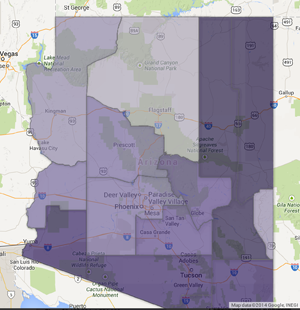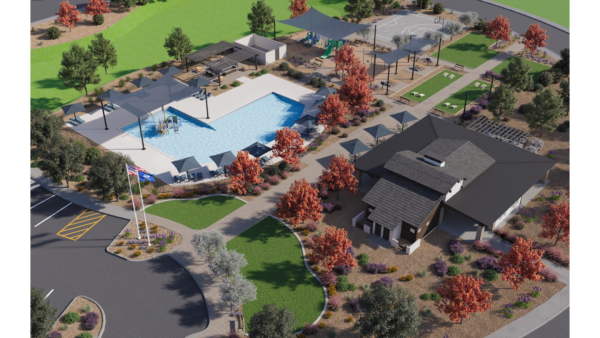By Julianne DeFilippis | Cronkite News
WASHINGTON – Arizona counties got nearly $34.5 million in funding this week for the federal lands within their borders, but those Payments in Lieu of Taxes may not continue in the future if Congress doesn’t act.
The Arizona funding was part of $436.9 million paid to about 1,900 local governments by the Interior Department under the PILT program, which has been compensating counties since 1976 for the property taxes they cannot collect on the government land.
The payments are particularly important in Western states because of the large amounts of federal land in those states. All 15 Arizona counties have enough federal land to be qualify for PILT funds, ranging from $844,890 in Greenlee County to $3.48 million in Yuma County.
“It’s good news for my district, which is unique because 95 percent of it is public land, so they really rely on these payments,” said Rep. Ann Kirkpatrick, D-Flagstaff, whose district includes some or all of 10 counties.
But this year’s payments almost didn’t come through. PILT was not included in the 2014 budget, but was added to the Farm Bill by lawmakers this spring.

There is currently no guarantee of funding beyond this year, however, which worries local government officials.
“You have to pay for your responsibility,” said Paul Beddoe, deputy legislative director at the National Association of Counties. “This is Congress’ way to pay taxes in these rural communities.”
The funds are based on the acres of federal land within a county, including national forests and parks, acreage managed by the Bureau of Land Management and other federal lands.
Beddoe said PILT funding is absolutely crucial, especially in states like Arizona, because it lets them fund needed services. Those can include building schools and roads but also funding services “to the benefit of federal land,” from search and rescue to land cleanup.
Arizona got the fifth-highest PILT payment among states: California got $45 million, followed by Utah with $37.9 million, New Mexico with $37.7 million and Colorado, with just over $34.5 million.
In its announcement Tuesday, the Interior Department said this year’s payment is the most-ever to states. But it still falls short, said Rep. Paul Gosar, R-Prescott.
Gosar noted that the federal government has locked up most of the state’s land, depriving state and counties of tax revenues, and gets “a fraction of its tax base back in PILT payments” in exchange.
“PILT is insufficiently funded and incorrectly calculated,” Gosar said in a statement released by his office. “I have fought to authorize PILT, and this current payout reflects that, since it is the only morsel Arizona can get at this time.”
Still, officials at the Arizona Association of Counties are grateful for the money and are working to make sure the program continues.
Even though counties have known for several months that the 2014 payment was on the way, the uncertainty over funding earlier this year was “incredibly stressful” for local governments, said Jen Marson, executive director of the Arizona counties association.
To keep that from happening again, Kirkpatrick has introduced a bill to permanently authorize funding for the program.
“PILT is critical for these rural communities and they need assurance that this money will continue to fund critical infrastructure,” she said.
A companion bill was introduced in the Senate by Sen. Mark Udall, D-Colo.
“We’re hoping these will get put through … so that Congress doesn’t have to worry about it anymore and so that counties don’t have to worry about it anymore,” said Mohave County Supervisor Buster Johnson, president of the counties association.
“We need permanent funding for PILT, instead of having to go back and beg Congress every few years,” Johnson said.
Bitter PILT
Payments In Lieu of Taxes, or PILT, payments reimburse local governments for potential property taxes lost for nontaxable federal lands within their borders. PILT payments for Arizona counties, with their federal acreage and payment per acre:
• Apache: $1,657,182; 662,515 acres; $2.50/acre
• Cochise: $2,142,985; 901,148 acres; $2.38/acre
• Coconino: $1,705,008; 4,740,391 acres; $0.36/acre
• Gila: $3,426,420; 1,771,484 acres; $1.93/acre
• Graham: $2,784,560; 1,099,637 acres; $2.53/acre
• Greenlee: $844,890; 905,970 acres; $0.93/acre
• La Paz: $1,928,269; 1,848,763 acres; $1.04/acre
• Maricopa: $3,011,264; 2,434,825 acres; $1.24/acre
• Mohave: $3,469,643; 6,421,638 acres; $0.54/acre
• Navajo: $1,519,256; 598,977 acres; $2.54/acre
• Pima: $3,152,584; 1,534,068 acres; $2.06/acre
• Pinal: $1,223,747; 618,750 acres; $1.98/acre
• Santa Cruz: $978,173; 432,662 acres; $2.26/acre
• Yavapai: $3,177,599; 2,599,553 acres; $1.22/acre
• Yuma: $3,476,376; 1,556,650 acres; $2.23/acre











